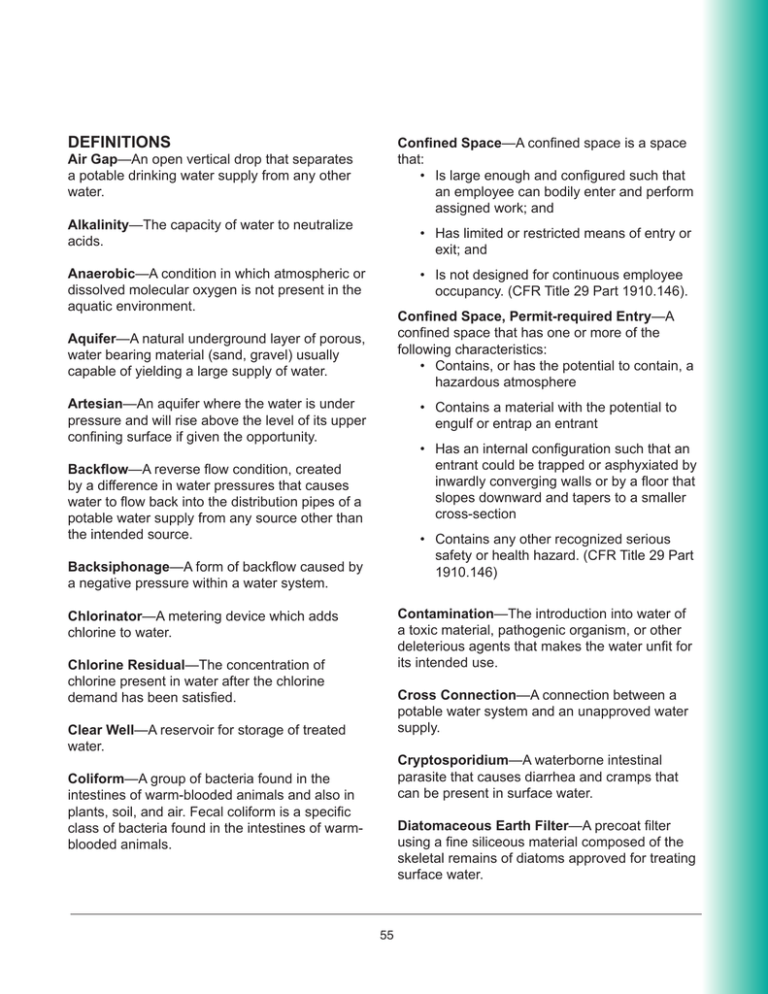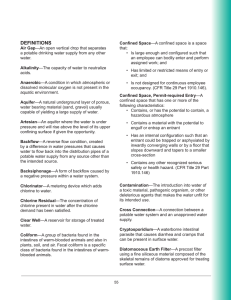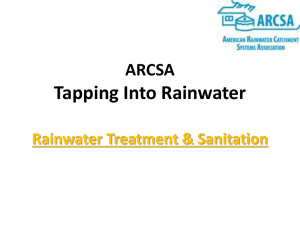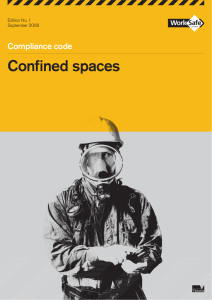DEFINITIONS
advertisement

DEFINITIONS Confined Space—A confined space is a space that: • Is large enough and configured such that an employee can bodily enter and perform assigned work; and Air Gap—An open vertical drop that separates a potable drinking water supply from any other water. Alkalinity—The capacity of water to neutralize acids. • Has limited or restricted means of entry or exit; and Anaerobic—A condition in which atmospheric or dissolved molecular oxygen is not present in the aquatic environment. • Is not designed for continuous employee occupancy. (CFR Title 29 Part 1910.146). Aquifer—A natural underground layer of porous, water bearing material (sand, gravel) usually capable of yielding a large supply of water. Confined Space, Permit-required Entry—A confined space that has one or more of the following characteristics: • Contains, or has the potential to contain, a hazardous atmosphere Artesian—An aquifer where the water is under pressure and will rise above the level of its upper confining surface if given the opportunity. • Contains a material with the potential to engulf or entrap an entrant • Has an internal configuration such that an entrant could be trapped or asphyxiated by inwardly converging walls or by a floor that slopes downward and tapers to a smaller cross-section Backflow—A reverse flow condition, created by a difference in water pressures that causes water to flow back into the distribution pipes of a potable water supply from any source other than the intended source. • Contains any other recognized serious safety or health hazard. (CFR Title 29 Part 1910.146) Backsiphonage—A form of backflow caused by a negative pressure within a water system. Contamination—The introduction into water of a toxic material, pathogenic organism, or other deleterious agents that makes the water unfit for its intended use. Chlorinator—A metering device which adds chlorine to water. Chlorine Residual—The concentration of chlorine present in water after the chlorine demand has been satisfied. Cross Connection—A connection between a potable water system and an unapproved water supply. Clear Well—A reservoir for storage of treated water. Cryptosporidium—A waterborne intestinal parasite that causes diarrhea and cramps that can be present in surface water. Coliform—A group of bacteria found in the intestines of warm-blooded animals and also in plants, soil, and air. Fecal coliform is a specific class of bacteria found in the intestines of warmblooded animals. Diatomaceous Earth Filter—A precoat filter using a fine siliceous material composed of the skeletal remains of diatoms approved for treating surface water. 55 Draw Down—The drop in water level when water is being pumped from a well. Nephelometric Turbidity Units (NTU)—The units of measure of turbidity, as made with a turbidimeter. EPA—The U.S. Environmental Protection Agency is a regulatory agency responsible for implementing the Safe Drinking Water Act. Nonpublic Water System—A potable water system that does not meet the definition of a public system. Fractures—A crack or opening in the surface of the earth that allows surface water to enter subsurface water. Pollutants—Organic or inorganic material that deteriorates the water’s quality. Frost Line—The lower ground depth of frost penetration. Public Water System—A potable water system that serves at least 25 people at least 60 days a year or has at least 15 service connection. Giardia—A waterborne intestinal parasite that causes diarrhea and cramps that can be present in surface water. Residual Chlorine—The concentration of chlorine present in water after the demand has been satisfied. Gravity Storage Tank—Water storage tanks that provide water system pressure by gravity. Safe Drinking Water Act—An Act passed by the U.S. Congress in 1974, administered by the EPA. Referred to as the SDWA. Ground Water—Water in an underground aquifer. Sanitary Protection—Any means of protecting water from contamination. Ground Water Under the Direct Influence of Surface Water—A ground water contaminated with surface runoff such as through fractures, improper well closures, or mining activity. Sanitary Seal—A wellhead cover used at the top of the well casing to prevent contaminated water or other material from entering the well. Hardness—A characteristic of water caused primarily by calcium and magnesium ions. Hardness causes deposits and scale to form on pipes and fixtures. Sanitary Survey—A detailed evaluation or inspection of a source of water supply and all treatment, storage, and distribution facilities to ensure protection of the water from all pollution sources. A sanitary survey must be performed by a qualified engineer. Iron—Metallic element number 26. This metal causes a rust stain and metallic taste when present in water in concentrations above 0.3 milligrams per liter. State Regulatory Agency—The State agency with regulatory authority over public water systems. Jet Pumps—A pump that utilizes a venturi effect to move water. Surface Water—Water on the surface of the earth such as in lakes, rivers, or streams. Manganese—This metal causes black stains and a metallic taste when present in water in concentrations above 0.05 milligrams per liter. 56 Turbidity—A condition in water caused by the presence of suspended matter, resulting in the scattering and absorption of light rays, reported as NTUs. Acknowledgements Water Table—The upper surface of the zone of saturation of ground water in an unconfined aquifer. Special thanks goes to Mary Dereske, P.E.; Satgur Klar, P.E.; John Leffel; Sarah Baker, P.E.; Kathy Snodgrass; Craig Lasser, P.E.; Jim Grubb, P.E.; Jay Westlake; Donna Wians, P.E.; and others for providing feedback, forms, photos, and technical review. Many people contributed their knowledge, assistance, and photographs toward the completion of this guide. Wellhead Protection Area—The surface and subsurface area surrounding a water well protected from potential contamination. Kathy Snodgrass supplied public notification forms. Yield—The quantity of water that can be collected from a water source. Example: a spring may yield 10 gallons per hour. Satgur Klar provided sampling plan examples. Susan Christensen helped with illustrations. Zone of Saturation—The level below the top of the ground water table. SDTDC’s national publications are available on the Internet at: http://www.fs.fed.us/eng/pubs. USDA Forest Service and U.S. Department of the Interior Bureau of Land Management employees also can view SDTDC’s videos, CDs, and individual project pages on their internal computer network at: http://fsweb.sdtdc.wo.fs.fed.us/. 57 58







